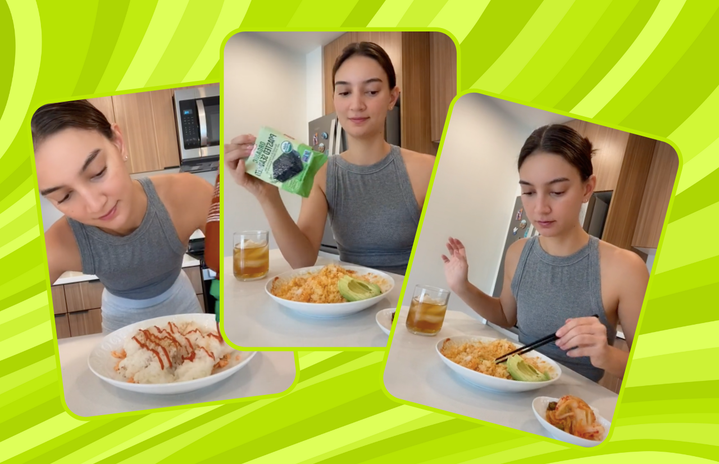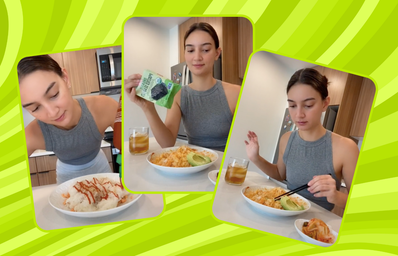If you’re on TikTok right now, you’ve definitely watched a video of someone flaking salmon, microwaving rice with a singular ice cube, and artfully zig-zagging Kewpie mayo and sriracha across the dish before enjoying each bite with a piece of seaweed.
If this video has popped up on your For You Page recently, you have Emily Mariko, a 29-year-old influencer living in the Bay Area, to thank. Mariko is a content creator who originally built her following on YouTube and currently has over 7 million followers on TikTok. Soon after Mariko’s salmon rice video was posted, the meal went viral and everyone began making TikToks with their own versions of the dish. There’s something equally mesmerizing and satisfying about these videos and how they emulate the original video’s clean, bright backdrop and ASMR-like soundscape.
For most, recreating Mariko’s salmon rice with spicy mayo is just an internet trend, but for me, it’s so much more. Discovering Mariko’s video on TikTok is the first time I’ve seen my culture reflected in the media. I’m a “hapa” just like Mariko, meaning we’re both half-Japanese and half-Caucasian. Growing up, my family ate rice with every meal. We always had extra rice to eat with lunch the next day, whether it was with fish, miso soup, or burgers. I also grew up in the Pacific Northwest where salmon is plentiful; so salmon rice was a childhood staple for me, not just a viral food trend.
Interestingly, Mariko and I both grew up in two “hotspots” with a large population of multiracial residents; herself in Los Angeles, and myself in the Seattle area. Mariko now lives in the Bay Area, another one of these hotspots, and I now attend a small (and predominately white) liberal arts college in New England. Moving from an area where I knew many people with the same racial heritage as me to a predominantly white institution (PWI) for college, my racial identity has become an undeniable part of my college experience.
Within the first week of college, I called my mom to tell her I had “never felt so Asian in my entire life.” Growing up in Seattle, I was never the “weird kid” for bringing onigiri for lunch because other kids in my class had brought it, too. In ninth grade, I had a group project where six out of the seven students were Asian, and five of those six were mixed half-Asian and half-white like me. Currently, the Asian community at my college encompasses many different identities, including Asian international students, Asian-American students of varying generations, and mixed-race Asian students. Now that I’m in college, I’ve become acutely aware of the Asian part of my identity; however, I still don’t fully identify with other Asians. I feel like my feet are straddling between two doors, but can never fully enter either room. I’m either “too Asian” or not “Asian enough” to truly belong to a fixed group.
Like myself, more than 33 million Americans identify as multiracial, a number that has increased by nearly 25 million people in the past decade, according to the 2020 Census. The population of white and Asian multiracial individuals has increased by 87% in the past decade. According to a 2021 article from The Washington Post, we’re currently living through a demographic shift in which the multiracial population is growing rapidly. Richard Alba, a demographer and professor of sociology at the City University of New York (CUNY), tells The Washington Post, “The mixing of all sorts [of races] is really a new force in 21st-century America.”
While the multiracial population in the United States is growing, what most Americans don’t realize is that there was a ban on interracial marriage that didn’t end until 1967 – even though the Civil Rights Act passed in 1964. Less than 50 years ago, the U.S. Supreme Court challenged laws prohibiting interracial marriages in Loving v. Virginia, and it has been 15 years since the U.S. Census Bureau started allowing Americans to select more than one race on their census forms. Honestly, the lack of recognition of America’s treatment of interracial marriage makes my multiracial identity feel “pushed under the rug” in a way — as if our history is being ignored.
The steadily rising population of multiracial individuals in the U.S. brings me a sense of belonging and hope; it helps to simply know that I’m not alone in navigating the complexities of a multiracial identity. However, at the same time, it’s uncomfortable to think that the conditions for my existence were illegal in America no less than half a century ago.
Last spring, the increase in anti-Asian hate crimes forced me to think even more about my identity and privilege as a half-Asian and half-white person. At the time, my news feed was flooded with reports of violence against Asians in the United States, and my social media feed was filled with posts and stories with the hashtag “#StopAAPIHate.” My grandparents lived in fear, leaving their house only when necessary and taking extra precautions when they did go out. A distant family friend was the victim of an anti-Asian hate crime in a city where I had grown up feeling at home as a half-Asian person myself.
The impact of COVID-19 on the treatment of Asians in America made me question my Asianess and my mix of cultures. I couldn’t put my finger on what “defined” being a half-Asian, half-white person. That was until I saw Emily Mariko making her salmon rice on TikTok. Watching that video was like a “eureka” moment for me; I felt like I had finally found a little definition to my half-Asian, half-white identity. Mariko’s salmon rice is a meal I often enjoyed growing up, and it also represents both parts of my identity coming together. The rice and salmon of the Pacific Northwest combined with sriracha and Japanese mayo, all eaten daintily with seaweed and chopsticks feel representative of my Asian and white identities — and when combined, they represent me.
When Mariko’s video first went viral, I wasn’t sure how to feel. Although the salmon dish is culturally significant to me, it seemed like just another viral food trend for people to try. Appropriation of food is an important issue; in addition to celebrating a dish and enjoying it, you want to respect the dish and its cultural significance. I sometimes feel activated by others recreating Mariko’s salmon rice, although I’m still reflecting on why. Perhaps it’s because, in my lifetime, I can think of many distinctly Japanese experiences I’ve had and many that were distinctly white, but few that truly represented my mixed identity. For me, Mariko’s salmon rice dish represents my full, complete identity, and that feels deeper than any viral TikTok trend.
Truthfully, I’m not always sure how to feel about my identity and the fact that Mariko’s rice dish went viral. However, I do know that people should be conscious of the historical significance of multiracial identity in our country. The multiracial population didn’t just appear out of thin air; we appeared after many years of racist policies and past generations continuously fighting for the right to exist. As the population of mixed-race individuals in the U.S. grows, I’m interested to see how our culture evolves, too; and that includes food. At the end of the day, I’m hopeful that I’ll continue to find that sense of belonging in both big ways and small, even if through a bowl of salmon rice.
Studies
Blanco, Foster-Frau, & Mellnik (2021). “‘We’re talking about a big, powerful phenomenon’: Multiracial Americans drive change.” Washington Post. Retrieved from washingtonpost.com.
U.S. Census Bureau (2020). 2020 Census Results. Retrieved from census.gov.


